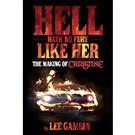|
|
||||
|
by Richard Jack Smith  Because I don't drive, I've never seen the fascination in cars. Other than getting from place to place, their appeal has eluded me. In cinema, vehicles have served a background function. Arguably, chase scenes did much to alter this perception. There was Popeye Doyle (Gene Hackman) commandeering a 1971 Le Mans in The French Connection or the Ford Mustang driven by Steve McQueen in Bullitt. Indeed, these examples show that when the spotlight falls on four wheels, it can be magnetic. Although Christine wasn't the first time a car was possessed by evil forces, the film holds as a cult classic. I have only seen the film once, the impression being that director John Carpenter did competent if unspectacular work. So does Lee Gambin's book Hell Hath No Fury Like Her: The Making of Christine make me want to revisit this Stephen King adaptation? Let's find out. I approached Gambin's book cautiously. Indeed, I struggled with his previous effort Nope, Nothing Wrong Here: The Making of Cujo due to its heavy psychological nature. The focus on psychoanalysis took away from the production trivia. Such a scholarly stance kept me at a distance. Surprisingly, Gambin's approach suited Christine. He includes many interviews with the cast and crew. On page 114, lead actor Keith Gordon had this to say: "I honestly feel that Christine truly is about relationships. The desperate need people have for them and how they can turn ugly... Also, I think that people are slaves to their things - their homes, their possessions, their work and yes, to their cars!" I read the book in paperback and there were numerous photographs depicting actors on the set. The quality of each image was very high indeed. Another matter which can make the difference between smooth vision and eye strain must be font size. Commendably, Gambin chose a text that was big and clear. Then again, what shows up rather poorly in Gambin's presentation are the acknowledgements between cast and crew. Although it's nice to know that these people worked well together, to be constantly reminded page and page made me feel there should be tighter editing. As such, the book runs at least thirty pages too long. In the chapter "You're Mine and We Belong Together," the author makes some excellent points. For several pages, he clearly defines the love triangle at the heart of Christine. Such material elevates the book considerably. Despite worthy material, frequent spelling mistakes can affect enjoyment of the text. For example on page 156, there's an error regarding Kim Gottlieb-Walker's quote. Clearly, this was meant to read as "hang out." However, a 'd' replaces the 'g' in the first word. A little nonchalant. Meanwhile, Donald M. Morgan elaborates on his fascinating process as a cinematographer. He talks about lighting by instinct and using available sources. I can relate to this because my video projects rely upon natural light and common household illumination. Also, Morgan stresses the importance in studying the grand masters, such as Rembrandt. By contrast, there's something entirely unexpected on page 158. A chap named Bill Gibson sells the experience of the "Christine Movie Car." Apparently, a museum contains memorabilia from Carpenter's film. A bit of shameless advertising, yet it made me smile. Ultimately, did Gambin's work make me want to see the film again? Not really. I prefer Elliot Silverstein's The Car, which continues to endure as the best hell on wheels flick, warts and all. Overall, I give Lee Gambin's Hell Hath No Fury Like Her: The Making of Christine three out of five stars. |
||
|
© 2025 - ReelTalk Movie Reviews Website designed by Dot Pitch Studios, LLC |



